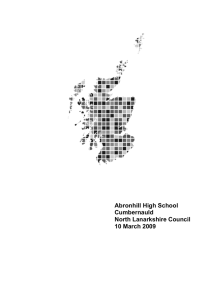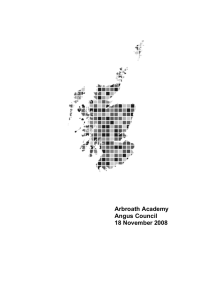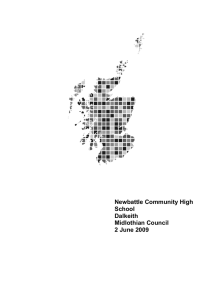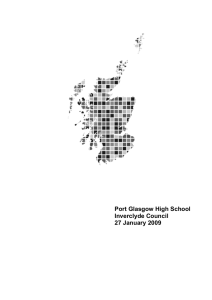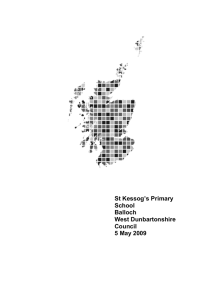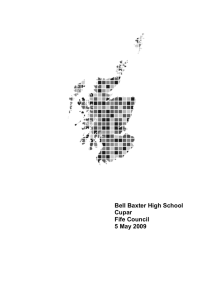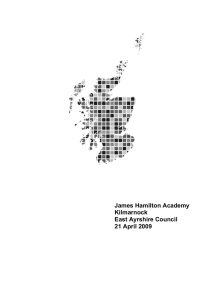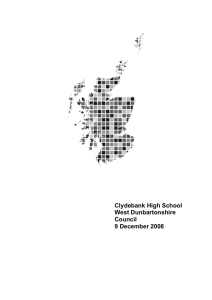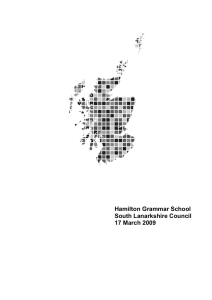Boroughmuir High School The City of Edinburgh Council
advertisement
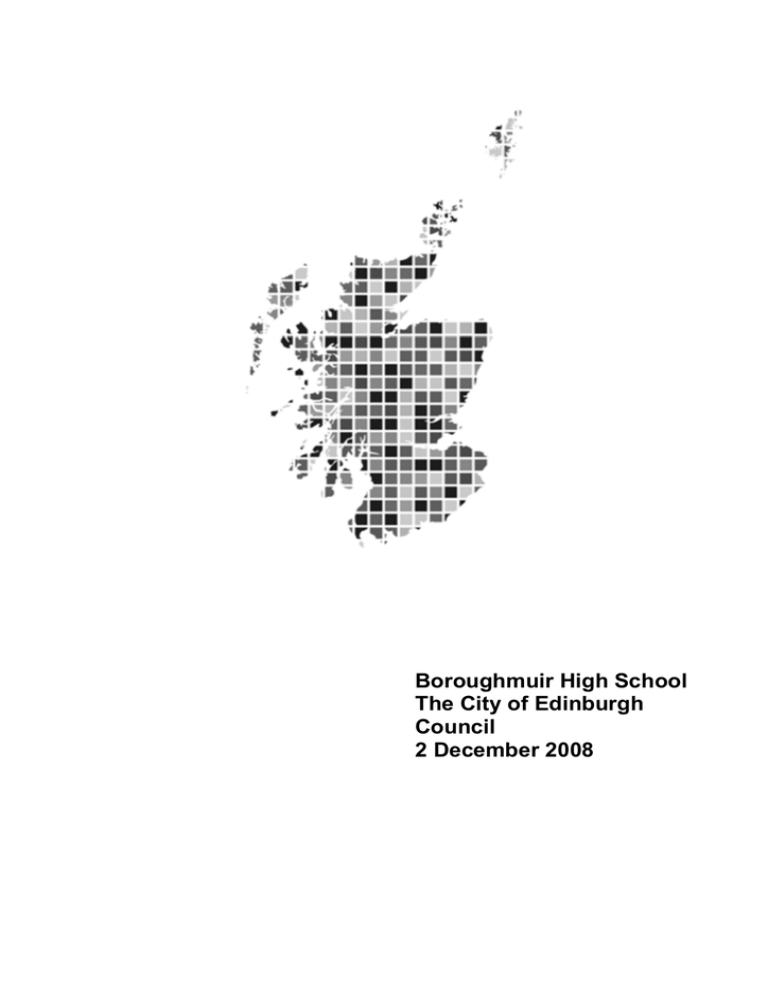
Boroughmuir High School The City of Edinburgh Council 2 December 2008 This report tells you about the quality of education at the school. We describe how young people benefit from learning there. We explain how well they are doing and how good the school is at helping them to learn. Then we look at the ways in which the school does this. We describe how well the school works with other groups in the community, including parents1 and services which support young people. We also comment on how well staff and young people work together and how they go about improving the school. Our report describes the ‘ethos’ of the school. By ‘ethos’ we mean the relationships in the school, how well young people are cared for and treated and how much is expected of them in all aspects of school life. Finally, we comment on the school’s aims. In particular, we focus on how well the aims help staff to deliver high quality learning, and the impact of leadership on the school’s success in achieving these aims. If you would like to learn more about our inspection of the school, please visit www.hmie.gov.uk. Here you can find analyses of questionnaire returns and details about young people’s examination performance. Where applicable, you will also be able to find descriptions of good practice in the school and a report on the learning community surrounding the school. 1 Throughout this report, the term ‘parents’ should be taken to include foster carers, residential care staff and carers who are relatives or friends. Contents 1. The school 2. Particular strengths of the school 3. Examples of good practice 4. How well do young people learn and achieve? 5. How well do staff work with others to support young people’s learning? 6. Are staff and young people actively involved in improving their school community? 7. Does the school have high expectations of all young people? 8. Does the school have a clear sense of direction? 9. What happens next? 1. The school Boroughmuir High School is a non-denominational school which serves the Bruntsfield , Morningside and Buckstone areas of Edinburgh City. This inspection was carried out in October 2008 at which time the roll was 1094. A third of young people who attend come from outwith the catchment area. Young people’s attendance was in line with the national average in 2006/07. 1 2. Particular strengths of the school • Confident, sociable and articulate young people who achieve widely in sport, music and drama. • The strong commitment of staff to the life of the school and their positive relationships with young people. • High quality achievement in examinations, particularly at S5/S6. • The quality of support from the Parent Council, Parent Association and Friends of Boroughmuir Trust. • The very positive lead given by the headteacher and his senior team. 3. Examples of good practice • Innovative approaches to promoting science education and supporting gifted and talented young people from P7 into S1. • Steps taken in history to plan for Curriculum for Excellence. • Actions taken in English to support individual learners. • The work of the school-based police officer. • The school’s support for high quality learning and achievement in drama. 4. How well do young people learn and achieve? Learning and achievement Most young people learn and achieve very well. They are enthusiastic and well motivated, especially when they are encouraged to be active 2 in their learning. They concentrate on learning and work well. Those in S5/S6 benefit from meeting regularly with their guidance teacher and year head. At times, the lack of space makes it difficult for teachers to organise group activities. Some learning time is lost through travelling to off-site playing fields, although the improved facilities are high quality. Young people enjoy learning but the quality of their experience varies across subjects. They need better access to ICT to extend and enliven their learning. Young people are confident and show care for each other. They feel that the school helps them to work to the best of their ability. Many are developing as responsible citizens through taking active roles in the Pupil Council, Eco School committees and health group. High numbers contribute successfully to school shows, orchestras and jazz groups. Young people in S6 organised a very successful range of school activities. They provide very good role models for their younger peers. In S1/S2, young people are developing their literacy and numeracy skills across the school as well as in English and mathematics. Their achievements in reading and writing have improved. Attainment in mathematics has been stable. By the end of S4, their performance across subjects in national examinations has been consistently well above the national average. It is not as good as other schools which serve young people with similar needs and backgrounds. By the end of S6, the proportion of pupils achieving Highers and Advanced Highers is well above the national average and in line with that of schools which serve young people with similar needs and backgrounds. Almost all young people, including those with additional learning needs, go into education, training or jobs when they leave school. Those with English as an additional language (EAL) make good progress. Curriculum and meeting learning needs The school has made a number of improvements to the curriculum. These include the successful introduction of drama in S1/S2 with 3 progression through to Higher and media studies from S3 to S6. Staff are beginning to cater more effectively for the needs of lower achieving pupils in S3/S4. Young people at S5/S6 have a wide choice of Higher and Advanced Higher courses developed in partnership with colleges and neighbourhood schools, but no religious education or core physical education. The curriculum is starting to address fully the needs of all young people staying on after 16. Successful focus weeks in equality, citizenship and responsibility need to be linked more closely to the development of young people’s skills. Staff work very well with local primary schools to help young people to settle well into S1. Staff now need to extend curricular links consistently across the school. Most teachers adapt work well to meet the different learning needs and interests of young people. In an increasing number of areas, teachers give young people feedback which helps them improve, and involve them in assessing their own and others’ work. In some subjects, teachers need to do more to adapt activities to meet the needs of all young people, especially lower achievers. Support for learning staff help teachers to identify, plan for and support the individual learning needs of young people. Staff in several areas are successfully running initiatives to meet the needs of those with dyslexia and literacy difficulties. Practice in meeting learning needs is not yet consistently effective across the school. 5. How well do staff work with others to support young people’s learning? The school engages creatively with a number of external partners to support young people’s learning. These include the Canongate Youth Project, Panmure House and the Working Together team. Partners feel valued and make a positive impact on the lives of young people. Specialist staff, including guidance and support for learning, identify early those young people with learning or social, emotional and behavioural needs. Guidance teachers should work more closely with college partners to monitor the progress of S5 pupils who are on full-time college courses. A police officer, who is seconded and based 4 in the school, has helped staff to deal with incidents, such as anti-social behaviour. Relations between young people and the local police have improved. Parents feel welcome in the school and find senior staff very approachable. The active Parent Council, Parent Teacher Association and Friends of Boroughmuir Trust are highly supportive of the school. 6. Are staff and young people actively involved in improving their school community? Morale is high in the school. All staff contribute well to working groups. They give generously of their time to enrich the experiences of young people through a wide range of out-of-school activities and voluntary study opportunities. Regular educational trips at home and abroad are popular features of the S1 to S6 Activity Week. Recently, the school has begun to involve staff in sharing good practice in teaching in order to learn from each other. This has promoted discussion of learning and teaching. Young people would like more say in how to improve the school, including how they learn. The school uses a number of appropriate approaches to help identify its strengths and where it needs to improve. A number of departments review their work regularly to improve outcomes for young people. 7. Does the school have high expectations of all young people? Staff actively promote a strong culture of achievement and young people are a credit to the school. They are articulate, well mannered and respectful of each other and staff. Rates of exclusions are low. Young people’s wide ranging achievements are celebrated through assemblies and the popular class of the month. They are encouraged to lead a healthy lifestyle. More work is needed by catering staff in partnership with teachers to promote healthy eating. Young people feel treated fairly and most feel safe and cared for in school. When they reach S6 they are trained as buddies and work very effectively in S1 classes to support learning. They have a number of appropriate opportunities for religious observance but these are not yet regular enough. The school is reviewing its curriculum to better meet the 5 needs of a small number of individual young people. Senior staff are reviewing the use of the support base to ensure that it works more effectively for those young people who attend. Most guidance staff take prompt action to tackle any concerns, including those related to bullying. Staff need further training on child protection. 8. Does the school have a clear sense of direction? The headteacher and his senior team have developed a very positive atmosphere in the school. Staff and young people feel their contributions matter and are valued. This is helping to build their confidence to take on leadership roles and responsibilities. Staff work together to take forward agreed school priorities. Some departments need to improve arrangements to ensure young people get the support they need, including by using support staff. There are plans to make much needed improvements to school accommodation, particularly for physical education, through the Wave3 project. Staff are well placed to take forward the national programme Curriculum for Excellence to meet all young people’s needs. 9. What happens next? As a result of the very good quality of education provided by the school, we will make no further visits in connection with this inspection. The education authority will inform parents about the school’s progress as part of the authority’s arrangements for reporting to parents on the quality of its schools. 6 We have agreed the following areas for improvement with the school and education authority. • Continue to make improvements to the curriculum in line with Curriculum for Excellence. • Improve self-evaluation to ensure consistently high quality learning and achievement for all young people. • Actively address the inadequate accommodation and facilities. Quality indicators help schools, education authorities and inspectors to judge what is good and what needs to be improved in the work of the school. You can find these quality indicators in the HMIE publication How good is our school?. Following the inspection of each school, the Scottish Government gathers evaluations of three important quality indicators to keep track of how well all Scottish schools are doing. Here are the evaluations for Boroughmuir High School. Improvements in performance Learners’ experiences Meeting learning needs very good good good We also evaluated the following aspects of the work of the school. The curriculum Improvement through self-evaluation Managing Inspector: Fiona Carlisle 2 December 2008 7 good good To find out more about inspections or get an electronic copy of this report go to www.hmie.gov.uk. Please contact the Business Management and Communications Team (BMCT) if you wish to enquire about our arrangements for translated or other appropriate versions. If you wish to comment about any of our inspections, contact us at HMIEenquiries@hmie.gsi.gov.uk or alternatively you should write in the first instance to BMCT, HM Inspectorate of Education, Denholm House, Almondvale Business Park, Almondvale Way, Livingston EH54 6GA. Our complaints procedure is available from our website www.hmie.gov.uk or alternatively you can write to our Complaints Manager, at the address above or by telephoning 01506 600259. If you are not satisfied with the action we have taken at the end of our complaints procedure, you can raise your complaint with the Scottish Public Services Ombudsman (SPSO). The SPSO is fully independent and has powers to investigate complaints about Government departments and agencies. You should write to SPSO, Freepost EH641, Edinburgh EH3 0BR. You can also telephone 0800 377 7330, fax 0800 377 7331 or e-mail: ask@spso.org.uk. More information about the Ombudsman’s office can be obtained from the website at www.spso.org.uk. This report uses the following word scale to make clear judgements made by inspectors. excellent very good good satisfactory weak unsatisfactory outstanding, sector leading major strengths important strengths with some areas for improvement strengths just outweigh weaknesses important weaknesses major weaknesses Crown Copyright 2008 HM Inspectorate of Education.
